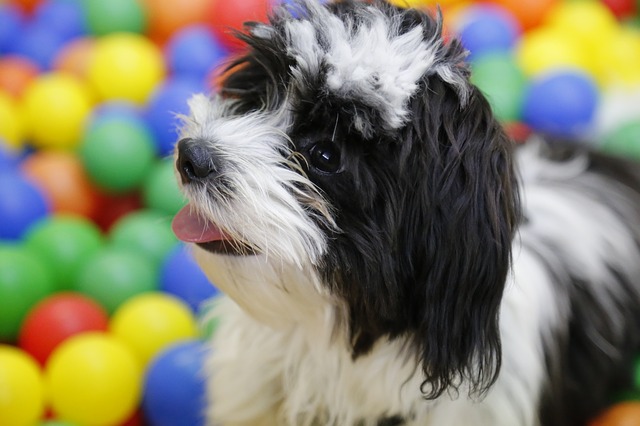Yes, Shih Tzus do shed, but because they have hair rather than traditional fur, the Shih Tzu shedding pattern is more like human hair than canine fur!
Canine Shedding
Typically, dogs are known for
- Shedding significantly year-round and having two “blowout” sheds during spring and fall (like the Husky)
or
- Shedding much less year-round and going through two “blowout” sheds during spring and fall (like the Labrador.)
The Shih Tzus do not fit neatly into either of these categories, and the reason is all down to that long silky coat.
Shih Tzus Coat
People often say that Shih Tzus have hair rather than fur because of the length and appearance of the their coat.
Shih Tzu is born with a fluffy coat resembling down fur.
The adult coat will begin to grow at four months, and by nine to twelve months, the double-layered adult coat (a thin short undercoat and a longer topcoat) fills out.
When fully grown, the Shih Tzu coat comes down to the floor; however, this coat length is usually limited to the show ring since it is not practical for pets.
Traditionally pet cuts keep the hair shorter to prevent matting and to keep the coat cleaner.
Maintaining a shorter coat requires grooming every four to six weeks.
Shih Tzu Shedding
Shih Tzus shedding is very similar to how humans shed hair. This makes them hypoallergenic.
There are four stages of hair growth – growing (anagen), transition (catagen), resting (telogen), and shedding (exogen).
During the anagen phase, the hair follicle pushes out the hair – these hairs continue to grow until they fall out or the next haircut.
Ninety percent of hair is in the anagen phase. This first phase of hair growth lasts for years.
During the catagen phase, hair growth slows down, and the hair follicles get smaller. The hair itself separates from the base of the hair follicle.
Around five percent of hair is in the catagen phase at one time. This phase lasts just over a week.
During the telogen phase, hair no longer grows and remains stagnant. Meanwhile, new strands of hair begin to form in the hair follicles.
During the exogen phase, the separated hair is shed, and the new hair continues to grow from the hair follicle.
The exogen phase lasts between two and five months.
Various factors influence the phases of the Shih Tzu hair growth cycle, including:
- Genetics
- Health
- Regularity of grooming
- Diet
Genetics
Genetics plays a role in the hair growth and loss cycle.
For example, some genes cause increased hair growth, and others can reduce hair growth.
Health
Several health conditions can influence the hair growth and loss cycle – including congenital and hereditary causes, parasitic, bacterial, fungal, and viral causes, and other causes of hair loss.
Congenital and Hereditary Causes of Hair Loss
- Alopecia
- Black hair follicle dysplasia
- Cutaneous asthenia
- Cutaneous mucinosis
- Familial vasculopathy
- Canine ichthyosiform dermatoses
- Hereditary congenital follicular parakeratosis
- Zinc deficiency syndromes
- Granulomatous sebaceous adenitis
- Vitiligo
- Epidermolysis bullosa syndromes
- Familial dermatomyositis
- Familial footpad hyperkeratosis
- Psoriasiform-lichenoid dermatosis
- Nodular dermatofibrosis
- Lethal acrodermatitis
- Zinc-responsive dermatopathy
- Albinism
- Hereditary lupoid dermatosis
Parasitic, Bacterial, Fungal, and Viral Causes of Hair Loss
- Demodex mange
- Sarcoptic mange
- Giardia
- Tapeworms
- Hookworms
- Folliculitis
- Pyoderma
Other Causes of Hair Loss
Topical products – anything that affects the health of dogs’ skin can influence hair follicles and cause hair loss, for example, shampoos that dry the skin or chemical treatments like flea and tick preventative.
If you suspect your Shih Tzu is losing hair because of an illness, infection, or skin irritation, consult your veterinarian.
Be sure to write down answers to the questions that your vet will ask:
- When did your dog start losing hair?
- Did anything seem to trigger your dog’s hair loss?
- Has your dog’s diet changed?
- Has your dog shown any other symptoms like scratching or biting at its fur?
- Have you been keeping up to date with monthly preventatives? Which monthly preventative do you use?
- Has your dog been anywhere new or unusual lately?
- Did a tick or any other insect bite your dog recently?
Regularity of Grooming
How regularly Shih Tzus are groomed also influences how noticeable their shedding is.
Regular brushing helps to remove loose and dead hair in the coat. Routine brushing also reduces the hair that dogs shed in the house.
Grooming is also crucial in keeping the Shih Tzu coat free from matting and tangles. Failure to groom a Shih Tzu regularly causes mats and tangles that –
- Weigh down the coat
- Tug on the skin
- Breed bacteria
- Contribute to odor
- Encourage infection
- Encourage parasites
When mats and tangles get out of control, the only solution may be to shave a dog’s full coat.
Mats and tangles in the coat are preventable with daily brushing and regular grooming every four to six weeks.
Diet
Like humans, what a dog eats influences their overall health and appearance.
For example, when dogs are malnourished and lacking vital nutrients, their coat will become dull and begin to thin.
Hair can even start to fall out when nutrition is poor.
How Much Do Shih Tzus Shed?
The hair growth and shedding cycle means that at any point in time, only ten to fifteen percent of hair is actively shedding.
When Do Shih Tzus Shed?
Throughout the year, Shih Tzu sheds hair in this hair growth and loss cycle.
Final Thoughts
Shih Tzu’s shed year-round, losing just ten to fifteen percent of their hair at one time.
Genetics, health, regularity of grooming, diet, and seasons affect shedding patterns.

